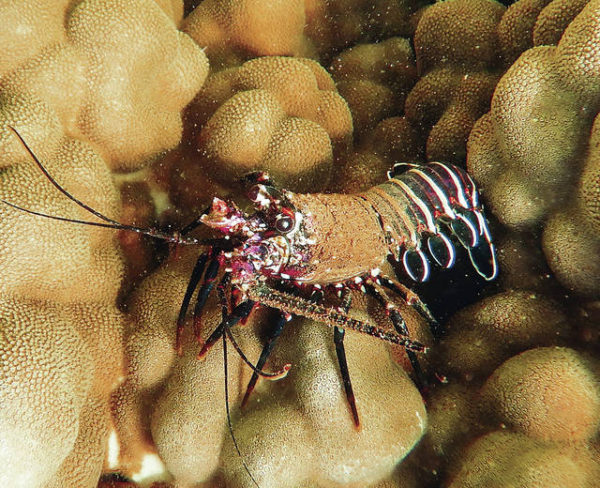Published in the Ocean Watch column, Honolulu Star-Advertiser © Susan Scott
December 8, 2018
I found a baby lobster backed into a coral crevice that was too shallow for it to hide in. The immature lobster had already lost its right antennae, and the left had been bitten down to a third of its normal length. Because the coral head had a deep, cavelike space below, I moved the youngster to that safer shelter. When my fingers wrapped around the bejeweled body, the little lobster cried.
Really. Spiny lobsters, which live in tropical waters, warn fellow lobsters of an approaching predator by rubbing an extension at the base of the antennae over a file located just below the base of each eye.
 This baby banded lobster is missing most of its two long antennae.
This baby banded lobster is missing most of its two long antennae.
The branched pair visible at the front are the lobster’s second pair.
All crustaceans have two pairs of antennae, all the better to forage for food.
©2018 Susan Scott
In some invertebrates, such as insects, at least one of these two sound-making surfaces is bumpy, like a washboard. Not our spiny lobsters. Rather, both surfaces are smooth, the reverberations coming from friction similar to bowed string instruments. However, the sound is not violin music to the ear, but a raspy wail.
The youngster I relocated was a banded spiny lobster, a species found only in Hawaii. Spiny lobsters rest during the day under ledges and in caves, often cozied up together at depths from a few feet to 600 feet. At night the lobsters roam sandy areas of the ocean floor, eating snails, clams, crabs and sea urchins.
Like all crustaceans, when it’s time to go up a size, spiny lobsters molt. To get ready for the expansion, the creature absorbs much of the calcium and other minerals from its old shell, using the materials for the new one. Puffing its soft body up with water causes the old, now- fragile shell to crack at the rear. The lobster backs out, hiding until the new shell hardens.
Hawaii hosts four spiny lobster species that lack the large front pincers of the Atlantic’s American lobster. Three spinies are common here — but not nearly as common as they once were. In 1948 the commercial catch was about 40,000 pounds. In 1968 the catch was less than 5,000 pounds.
Since then Hawaii’s lobster fishery has been regulated. Lobster hunting and trapping is prohibited in May, June, July and August, the creatures’ breeding season. Females with eggs are always off-limits, as are immatures, defined as measuring less than 3.25 inches from the base of the eyes to the rear of the top shell. Spearing is never allowed.
A female’s eggs are visible, held under her tail for about four weeks until they hatch. Large females can produce a half-million eggs each time, spawning up to four times per year.
The sound of the little lobster I rescued reminded me of a scuba dive I did years ago in Kaneohe Bay. For an hour I listened to six spiny lobsters cry out as the dive master carried them around in a net bag. Later she dumped the distressed animals on the lawn and dropped them, still calling in alarm, into an outdoor freezer.
I’ve never eaten any kind of lobster since.